
How to conduct virtual Kaizen Events using Microsoft Teams
This blog has been co-authored with Yury Gomez, Business Strategy Leader, WW Manufacturing

While the manufacturing industry has long been one of the leaders driving digital innovation, helping to fuel growth and redefine efficiencies, today’s disruptions—whether these are travel restrictions, increased health & safety precautions, or a new world of modern work—are challenging the traditional approaches used to facilitate agile process improvement. Thinking about today’s disruptions, Microsoft has deepened its investment in supporting the manufacturing industry and Microsoft Teams solutions that can enable organizations to reach their goals.
The ability for companies to be agile and flexible, leveraging the power of digitization to become more efficient, productive, and resilient will determine which companies will thrive in business. We have seen this with our customers like Honeywell, who turned factory acceptance tests virtual with RealWear and Microsoft Teams, and Alcoa, who deployed Teams to transform their shift schedules and improve communication to keep everyone informed with the rural plant operations.
In most organizations, continuous process improvement is fundamental to driving agility and business impact. While there are many different process improvement methodologies, one specific process that is core for driving agile change is Kaizen Events.
A Kaizen Event is where process owners and experts come together to discuss issues, brainstorm solutions, and create implementation plans. It is a collaborative effort with the goal to improve, identify, and address the root cause of issues so the organization can increase efficiency, enhance product quality, and reduce waste and costs. Because this type of event is typically done in person, the global health crisis has accelerated the need for companies to reimagine ways of working to minimize disruption in their operations.

At Microsoft, our mission is to empower every person and organization on the planet to achieve more. We build tools and solutions for manufacturers to adapt to new ways of working and fill technology gaps to enable their success. Our goal is to provide business decision-makers with best practices to help them think big, start small, and go fast as they embrace their digital transformation journey. From virtual inspections to Kaizen Events, we recognize that workers empowered by the right technology are more productive, confident, and better engaged at work.
With that in mind, we wanted to provide our perspective on how Kaizen Events can help manufacturers maintain business continuity during these uncertain times. Microsoft Teams enables your employees to conduct Kaizen Events virtually from the safety of their home while maximizing team engagement and achieving excellent outcomes.
How to use Teams for Kaizen Events

Prepare
For a successful Kaizen Event, identify the themes, share your goals, sponsors, and stakeholders prior to the start of the event to ensure alignment.
Create a team within Teams for the relevant participants and structure the channels to follow your event’s needs and schedule a kickoff meeting. The General or Introduction channel can be used to share information, event details, training materials, FAQs, etc. so everyone comes prepared.
Set up a poll or survey to gather feedback and gain consensus on the key issues to tackle during the Kaizen event.
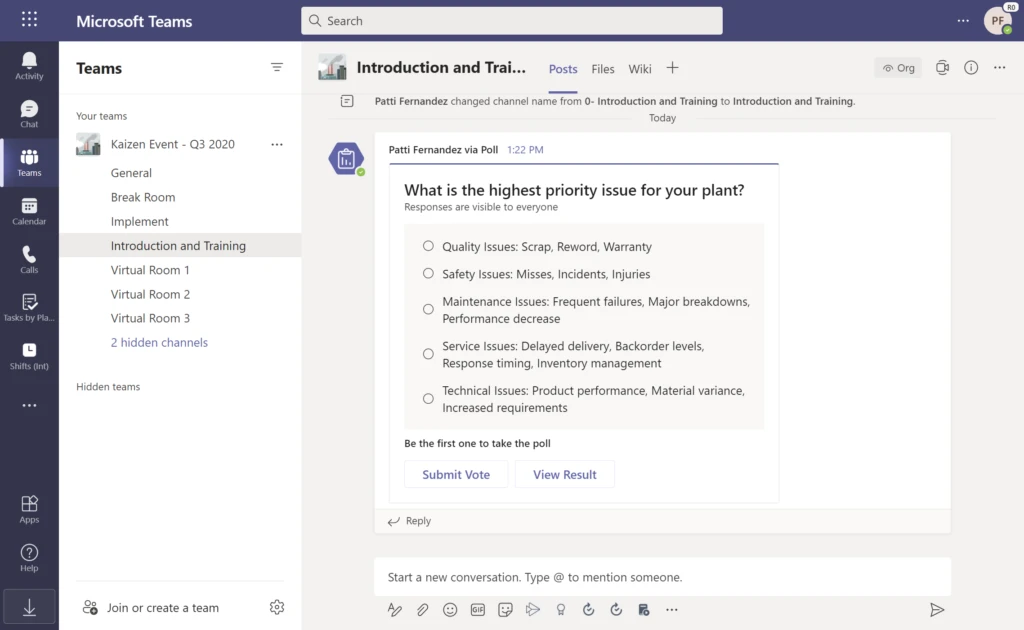
Another option is to leverage the existing PowerApp called Employee Ideas to generate, organize, and vote upon ideas.
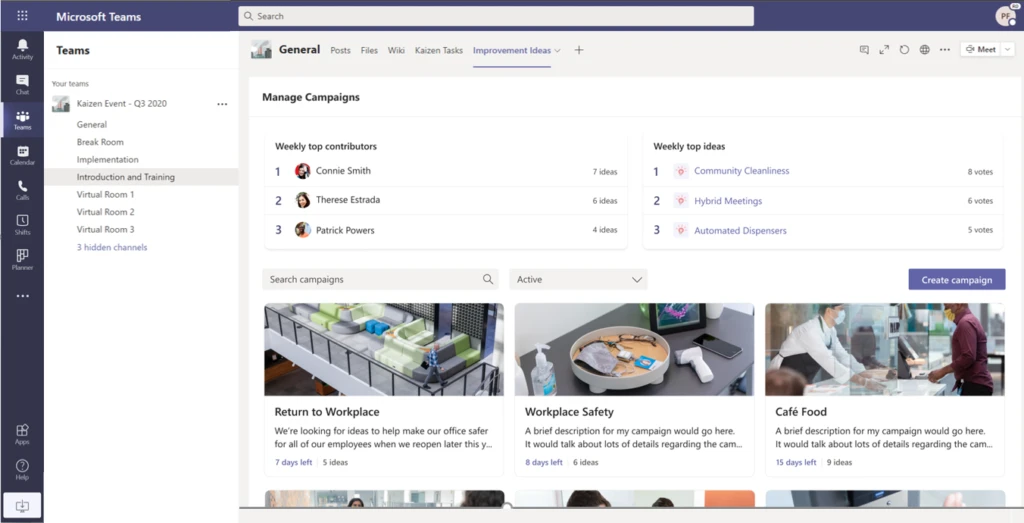
Kickoff the event

Begin the Kaizen Event by joining the scheduled meeting. Reiterate the event’s themes and topics, align on issues to tackle, set expectations and the cadence for the event at the onset. Enrich your experience by using icebreakers to emulate the people bonding aspect for the team to network and have casual conversations.
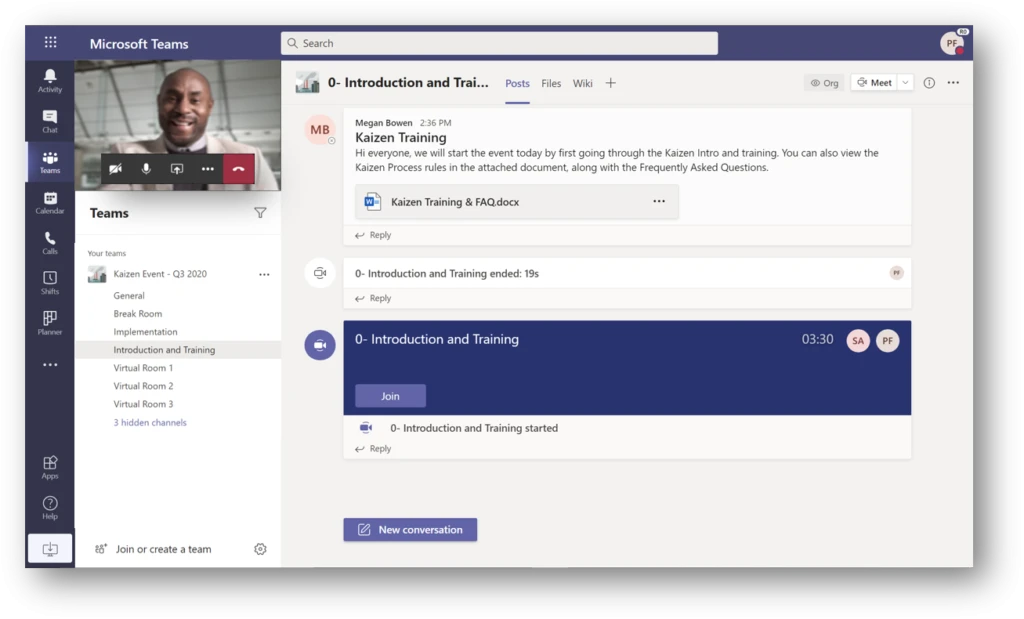
Divide people into groups

Once the top issues are finalized, divide people into groups to deep-dive into the selected topics, and to collaborate and brainstorm in virtual rooms.
This can be done via channel meetings in the respective topic-specific channels or in smaller groups using the breakout rooms feature in meetings.
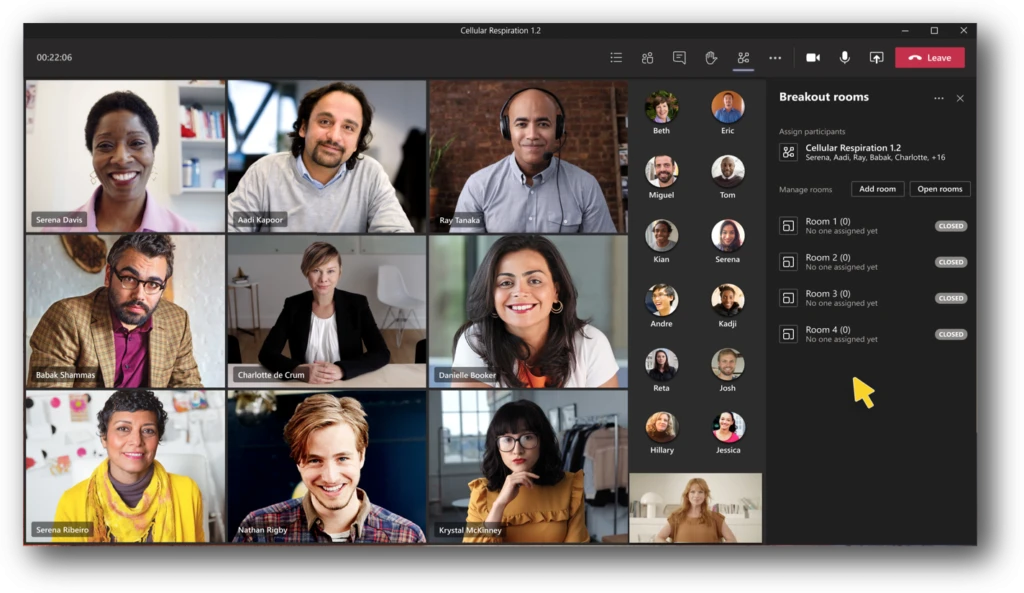
Issue deep-dive

Participants can easily collaborate by sharing and co-authoring documents, pictures, videos, historical data, etc. to continue deep-diving into the issues. For a richer experience, use apps to capture notes and outcomes during your meeting. With newly released meeting integrations you can now bring your project and incident management apps, polling, and analytics within the context of your meetings.
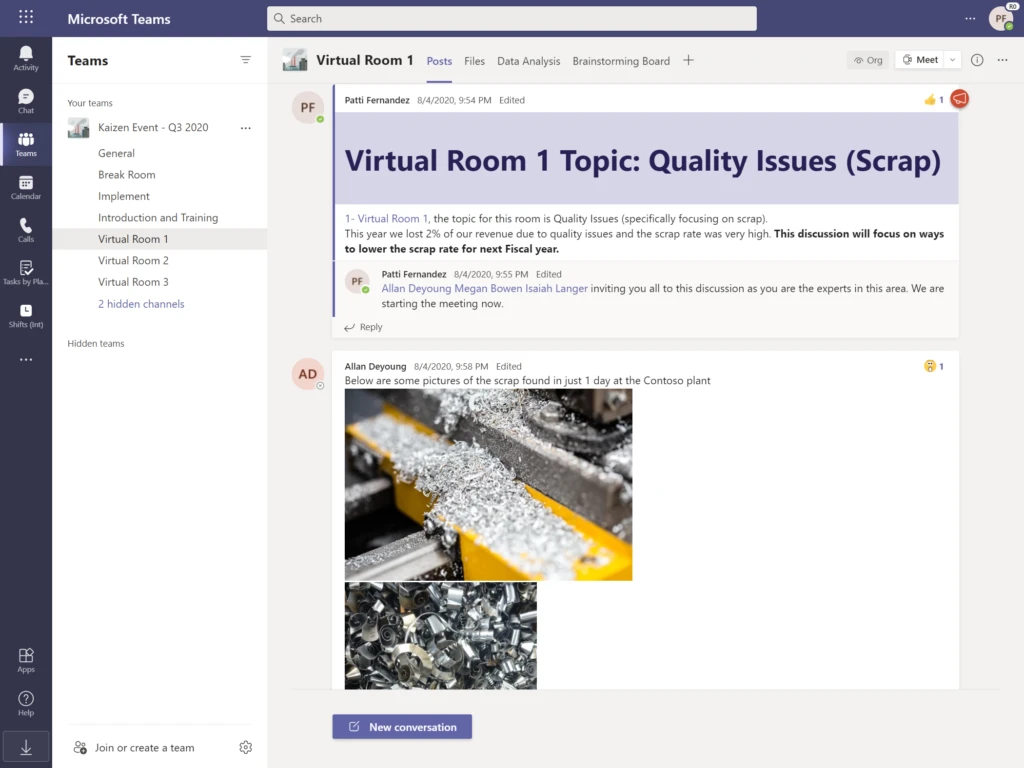
To investigate the root cause analysis, participants need to brainstorm ideas and leverage each other’s knowledge. In a typical in-person Kaizen Event, this is done using sticky notes and whiteboards. To emulate this experience, participants can use virtual whiteboarding options for visual brainstorming and coauthoring, allowing everyone to easily collaborate remotely.
Brainstorming

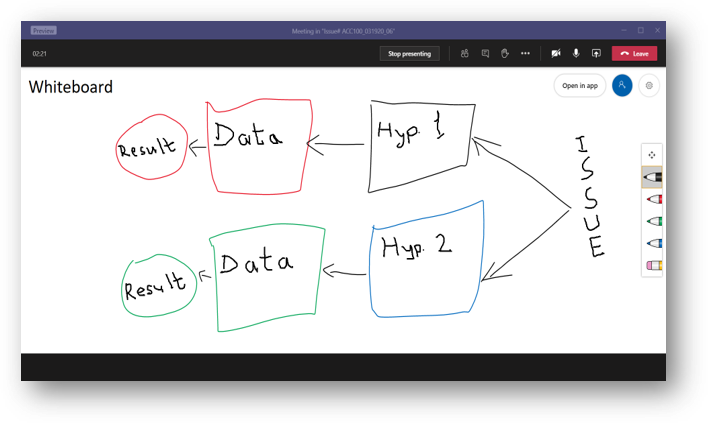
Sticky notes can also be replicated by assigning colors to participants, using the Tasks app as a Brainstorming board.
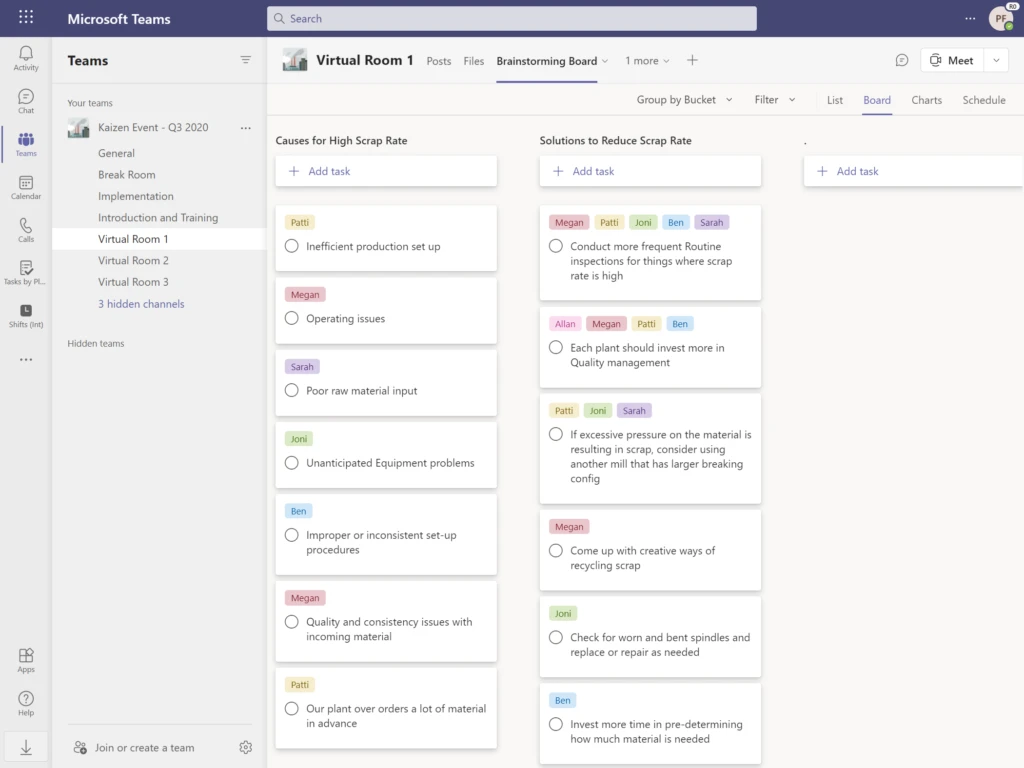
Share results

Once the brainstorming is complete, results can be shared from the respective virtual rooms by uploading details, final presentations, and meeting notes to the predetermined Implementation channel.
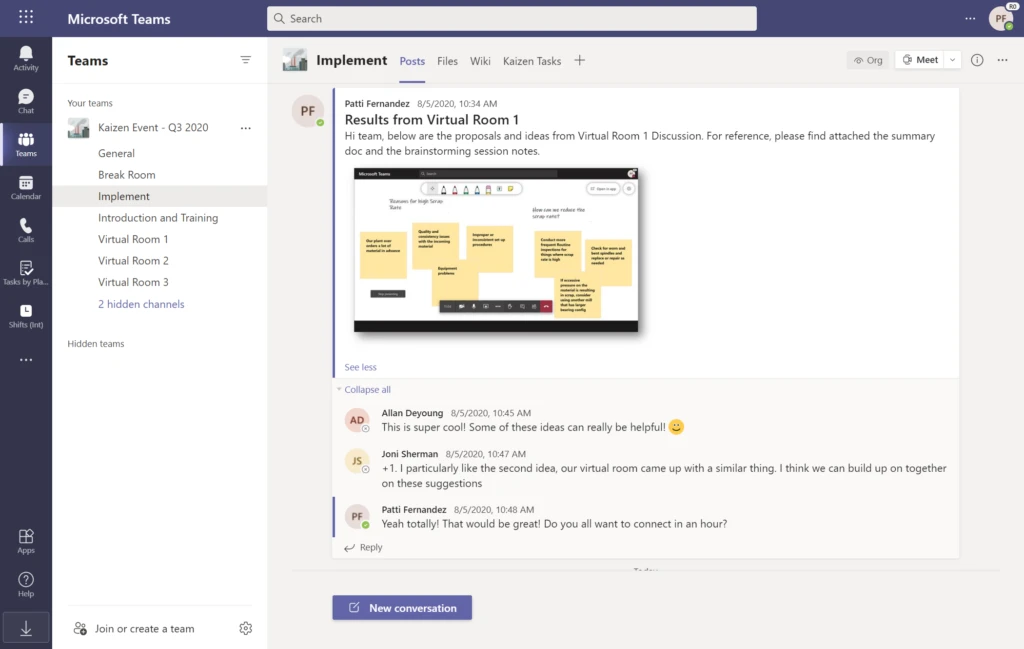
Execute and track progress

When the Kaizen Event ends, track the team’s initiatives and progress across dashboards, task lists, and more in the Implementation channel.
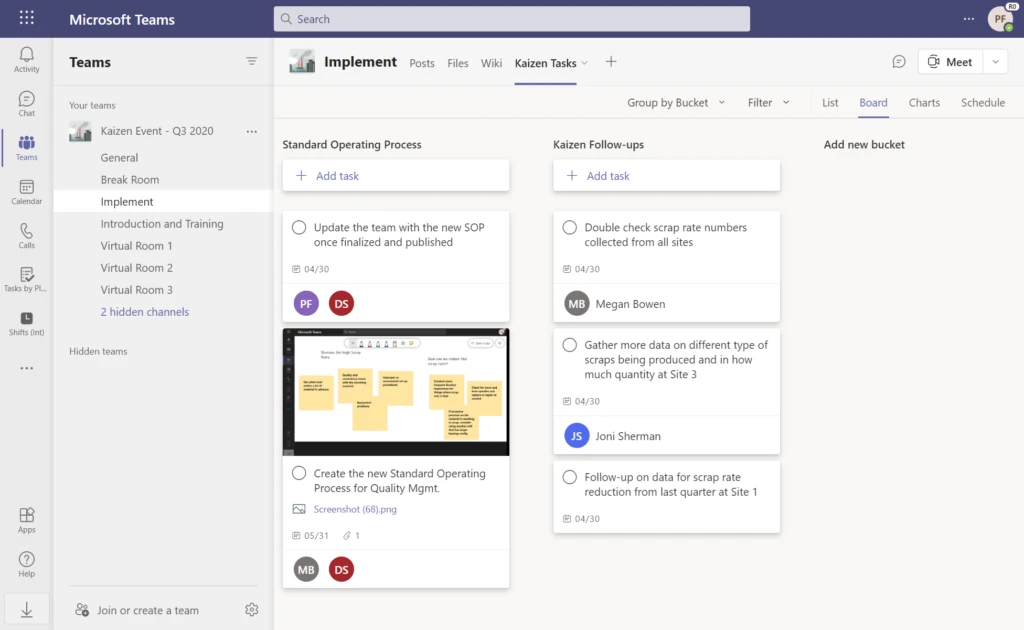
When all actions related to the Kaizen Event are complete archive the Team, which allows you to refer to the Team and the event’s outcomes at any time but does not crowd your ongoing Teams experience.
Benefits of Virtual Kaizen Events using Microsoft Teams
Although Kaizen Events were disrupted in unpredictable ways, there have been newfound advantages to moving these events virtually. Microsoft Teams allows you to support Kaizen Events from initiation through execution to completion. Teams enables enterprises to continue their lean processes, keep stakeholders engaged, and drive team engagement during the event, providing an easy way to align, execute, and measure all in one tool. Learn more about Microsoft’s deep investment in the manufacturing industry and the Microsoft Teams solutions that can help support your organization’s efforts.

Stay informed about Microsoft Cloud for Manufacturing to learn how you can help manufacture a more resilient and sustainable future.




